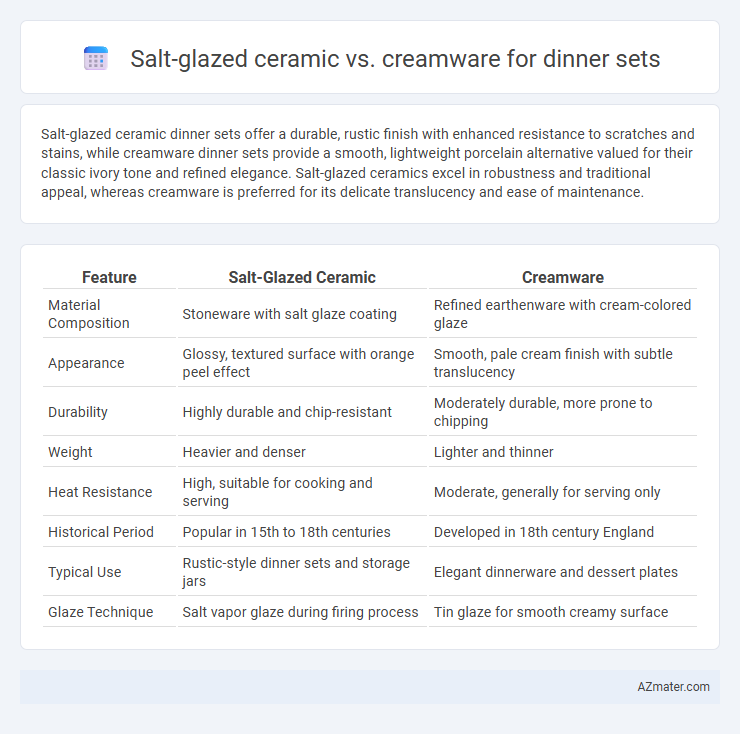Salt-glazed ceramic dinner sets offer a durable, rustic finish with enhanced resistance to scratches and stains, while creamware dinner sets provide a smooth, lightweight porcelain alternative valued for their classic ivory tone and refined elegance. Salt-glazed ceramics excel in robustness and traditional appeal, whereas creamware is preferred for its delicate translucency and ease of maintenance.
Table of Comparison
| Feature | Salt-Glazed Ceramic | Creamware |
|---|---|---|
| Material Composition | Stoneware with salt glaze coating | Refined earthenware with cream-colored glaze |
| Appearance | Glossy, textured surface with orange peel effect | Smooth, pale cream finish with subtle translucency |
| Durability | Highly durable and chip-resistant | Moderately durable, more prone to chipping |
| Weight | Heavier and denser | Lighter and thinner |
| Heat Resistance | High, suitable for cooking and serving | Moderate, generally for serving only |
| Historical Period | Popular in 15th to 18th centuries | Developed in 18th century England |
| Typical Use | Rustic-style dinner sets and storage jars | Elegant dinnerware and dessert plates |
| Glaze Technique | Salt vapor glaze during firing process | Tin glaze for smooth creamy surface |
Introduction to Salt-Glazed Ceramic and Creamware
Salt-glazed ceramic is a traditional pottery technique where salt is introduced into the kiln during high-temperature firing, creating a distinctive glossy, textured surface resistant to chipping and heat. Creamware, developed in the 18th century, is a refined type of earthenware characterized by its smooth, pale cream-colored glaze and delicate, lightweight structure, favored for its elegance and durability in dinnerware. Both materials offer unique aesthetic and functional qualities, with salt-glazed ceramic excelling in rustic, robust appeal and creamware prized for its classic, refined appearance.
Historical Origins and Evolution
Salt-glazed ceramics originated in 15th-century Germany, characterized by a durable, glossy surface created through salt vapor in the kiln, evolving as a functional ware in Europe for centuries. Creamware emerged in mid-18th-century England, developed by potters like Josiah Wedgwood, featuring a refined, pale yellow glaze designed for elegant yet affordable dinner sets. Both styles reflect distinct historical craftsmanship trends, with salt-glazed ceramics emphasizing rustic durability and creamware epitomizing the rise of mass-produced, refined tableware.
Key Material Differences
Salt-glazed ceramic features a distinctive glossy, textured surface created by introducing salt into the kiln during firing, resulting in a durable, non-porous finish ideal for rustic dinner sets. Creamware, developed in the 18th century, is a refined earthenware with a smooth, cream-colored lead glaze, prized for its lightness and elegant appearance. The key material difference lies in salt glazing's robust, tactile finish versus creamware's delicate, translucent glaze, affecting both durability and aesthetic appeal in dinnerware.
Distinctive Aesthetic Characteristics
Salt-glazed ceramics showcase a unique textured surface with a glossy, slightly pitted finish created by sodium vapor during firing, resulting in an earthy and rustic aesthetic perfect for artisanal dinner sets. Creamware, originating in the 18th century, features a smooth, pale cream-colored surface with a refined, delicate appearance that complements elegant and traditional table settings. The distinctive visual contrast lies in salt-glazed ceramics' organic, tactile quality versus creamware's polished, uniform glaze and soft, warm hues.
Durability and Everyday Use
Salt-glazed ceramics exhibit exceptional durability due to their dense, vitrified surface, making them highly resistant to chips and scratches in everyday use. Creamware, characterized by its lighter weight and smoother finish, offers reasonable strength but is more prone to crazing and damage under frequent handling. For long-term, practical dinner sets, salt-glazed ceramics provide superior resilience in routine dining environments.
Maintenance and Cleaning Requirements
Salt-glazed ceramic dinner sets feature a dense, glass-like surface created by vaporized salt during firing, making them highly resistant to staining and easy to clean with mild detergents. Creamware, a refined earthenware with a smooth, glazed finish, requires gentler care to avoid chipping and is best washed by hand to preserve its delicate glaze. Both types demand avoiding abrasive scrubbers and sudden temperature changes to maintain their appearance and longevity.
Suitability for Modern Dining
Salt-glazed ceramic offers a rustic, durable finish ideal for casual modern dining, resisting chipping and maintaining a handcrafted aesthetic. Creamware provides a smooth, refined surface with a delicate cream color, perfectly suited for elegant, contemporary table settings. Both materials balance functionality and style, but creamware's lightweight nature enhances ease of use in formal dining environments.
Price Comparison and Value
Salt-glazed ceramic dinner sets typically cost more due to their handcrafted nature and durable, textured finish, appealing to collectors seeking artisanal value. Creamware dinner sets are generally more affordable, offering smooth cream-colored surfaces with a classic look that fits everyday use and budget-friendly preferences. When comparing value, salt-glazed ceramics provide long-lasting hardness and unique aesthetics justifying higher prices, while creamware balances cost-effectiveness and functional elegance for daily dining.
Environmental Impact and Sustainability
Salt-glazed ceramics typically involve a high-temperature firing process that emits salt vapors, which can contribute to environmental pollution, whereas creamware, made from refined white earthenware, requires lower firing temperatures, resulting in less energy consumption. Creamware's production often uses fewer natural resources and produces less waste, making it a more sustainable option for dinner sets. Both materials are durable and long-lasting, but creamware's overall lower carbon footprint enhances its environmental appeal.
Choosing the Right Dinner Set for Your Home
Salt-glazed ceramic dinner sets offer a rustic, durable finish ideal for a farmhouse or traditional kitchen, providing natural resistance to chipping and a unique textured surface. Creamware, known for its smooth, pale ivory glaze and lightweight form, suits minimalist or classic decor, delivering a refined, elegant dining experience. When choosing the right dinner set for your home, consider the balance between aesthetic appeal, durability, and daily use practicality to match your lifestyle and interior design.

Infographic: Salt-glazed ceramic vs Creamware for Dinner Set
 azmater.com
azmater.com